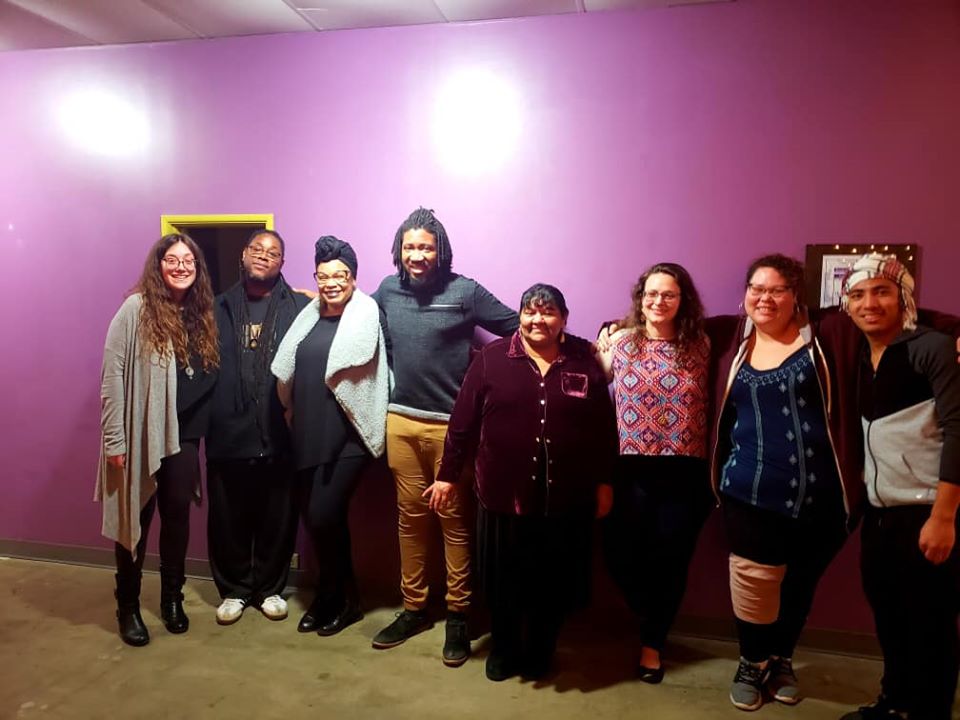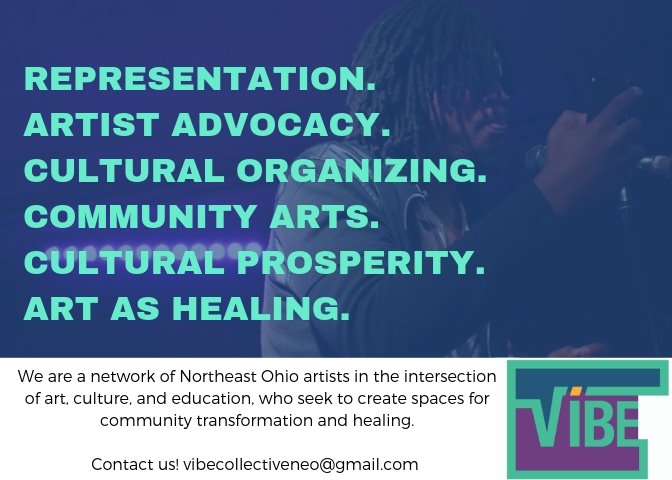10 Ways to Partner with Community Artists in the New Year
By: Amber Cullen

In the small city of Akron, Ohio, a group of artists organize as VIBE Collective. We are “a network of Northeast Ohio artists in the intersection of art, culture, and education, who seek to create spaces for community transformation and healing.”
Representation. Cultural Organizing. Advocacy. Community Arts. Arts as Healing.
VIBE Collective was formed as an all-volunteer run network in January 2018 because we found a commonality in our shared stories. It wasn’t only our stories about being artists. It was also our stories about our communities, about our ancestral legacies, about our communal pains and struggles, about the ways that we were all different and yet connected. Our work ranges among advocacy and representation for the Black community, LGBTQ+ community, Indigenous community, New Americans, artists of all abilities. We are poets, theatre artists, visual artists, organizers, performers, and community leaders. We are #artrepreneurs. (Check out some of the work of our network on Facebook.)

Throughout the organizing of our network, a breadth of knowledge arose from us as ones who have worked alongside institutions in partnership. We’ve often been on the receiving end of challenging experiences with businesses and civic and cultural institutions in all forms and sizes, and from those experiences have been able to curate a list of ways to partner with community artists. Our hope is that you will pass this list along to your organizations, colleagues, and staff. Together, we can build a brighter future through the arts.
10 Ways to Partner with Community Artists
1.) Make grants more accessible to community artists.
The grant world has many barriers for community artists: language, access to information, access to grant writing skills. Work that happens on the community level is highly effective and underfunded. Alleviate barriers by walking alongside groups in accessing opportunities.
2.) Co-create grant proposals for projects with community artists.
Co-create projects with artists that align with both institutional goals and the goals of the artist, and the community they work alongside, alleviating some of the barriers present in number one. Likewise, if you’re submitting grant proposals for projects that are to be in collaboration with the community, let the community be involved in the process from grant writing to finish.

3.) Help improve the health of the gig economy.
Being a full-time artist is incredibly unpredictable—living grant to grant and project to project. Bettering the health of the sector is one of the greatest supports. Advocate for us. Connect us to people of influence. Walk alongside us in professional development.
4.) Invest resources into artists of marginalized identities.
So many studies have been conducted and consultants hired in the name of diversity, equity, and inclusion—with little action. Invest resources directly into artists of marginalized identities, and organizations led by artists of marginalized identities. Be a partner in OUR work.
5.) Partner, not patronize—don’t tokenize.
Hire community artists and artists of marginalized identities in PARTNERSHIP, not to check a box on the list of diversity, equity, and inclusion. We have just as much to offer the arts and culture sector as you do. Refrain from tokenizing questions/conversations like, “What do _______ people like?” or “We are diverse. ________ is on the team.” Being devoted to diversity is being willing to ever-evolve and adjust to the nuances of our global, changing society.
6.) As a leader in the arts: check your privilege, be held accountable, give up power.
Be intentional in your hiring practices and succession planning, and always seek to understand—not only to be heard. Take a chance on someone younger than you. Use your privilege to create space for others to lead.
7.) Hire community artists for community engagement campaigns/projects.
If your project has an emphasis on community engagement, there is no better artist to hire than one who has an existing web of community relationships and community respect.

8.) Community works at the pace of relationship, not email.
Community work has myriad cultural differences, economic differences, etc., even in the arts. Not everyone gets information the same way. For many, Facebook messenger or calling is the preferred means of contact. Be patient and learn your community.
9. Come to our events, performances, shows, workshops.
Show up for us. Presence speaks volumes.
Fund artists. We are leaders.
Northeast Ohio is not unique in having a wealth of community and grassroots artists who are changemakers, who bridge communities, and who fight for a world of greater representation and equity. Wherever you live, seek out your artists. Resource us. We are leaders and partners in the work.

“I see [VIBE Collective] as an essential group that brings together many diverse and unique artists of every medium for the purpose of mutual support, encouragement, and promotion, while at the same time giving those artists opportunities and platforms to share their talents in the greater community … I have met so many wonderful people through VIBE Collective that I would probably not have otherwise met and that I now count among my friends. VIBE Collective has been very important to the development of my poetry career, and really helped launch it.” —Barbara Marie Minney